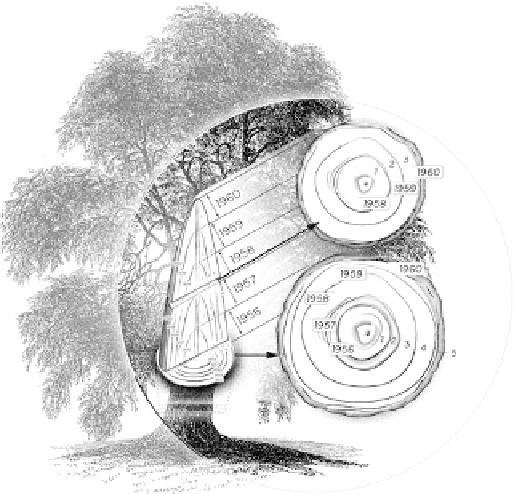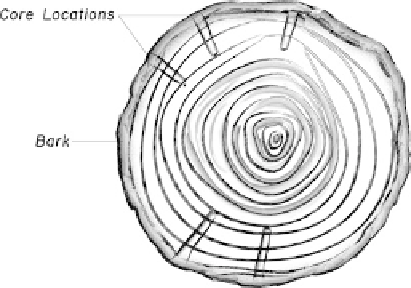Environmental Engineering Reference
In-Depth Information
chemical properties of the contaminant. Ma and Burken
(2002) were able to determine partition coefficients for
these
contaminants
because
they
added
known
concentrations to vials that contained weighed cores.
Finally, the tree-core-tissue collection method may one
day be replaced using passive
in-situ
methods. Rather than
collecting multiple cores from the same tree over time at a
site, a passive sampler could be installed in one core hole and
then sampled repeatedly over time. This assumes that the
installation of the sampler does not affect the movement of
sap or contaminants through the tree and that the samples
collected are representative. Such samplers could be based
on semipermeable membrane devices (SPMD); time-
weighted average solid-phase microextraction (TWA-
SPME) methods (Burken and Ma 2006; J. Burken, pers.
commun. 2009); or polyethylene devices (PEDs) (Adams
et al. 2007). The ultimate method selected, however, will
come down to the goals of each site project.
Fig. 15.6
The vertical location of core collection up a tree's trunk will
affect the results of any contaminant delineation survey, because the
higher the level above ground, the younger the rings that will be
sampled from the same corer. In the example above, ring 3 relates to
growth in 1958, whereas this would equate to ring 1 higher in the tree.
15.1.3 Diffusion Traps
The diffusion rate of TCE in stems was found to directly
relate to the transpiration rate (Ma and Burken 2003). To
determine this, they used diffusion traps, which consist of a
short section of 1-in. (2.54 cm)-diameter glass tubing
inserted over a cutting, and closed at each end by a stopper.
The application of diffusion traps is most appropriate for
contaminants that have high vapor pressures and high
Henry's law constants. In the tree center, where the xylem
contained the TCE with decreasing concentrations up the
tree (diffusion in vertical flow direction), TCE
concentrations also decreased radially laterally from the
center to the atmosphere, caused by diffusion.
On account of this vertical and radial diffusion to the
atmosphere, it is not surprising that less than 0.05% of the
TCE added to the soils was detected in the plants at the end
of the experiment (Ma and Burken 2003). The lack of TCE
detection in leaves may be a result of stem TCE diffusion
rates being higher than the diffusional transport of TCE in
the xylem to the leaves. This is especially true for ring-
porous trees that have most solution transport nearer the
bark/atmosphere interface, resulting in a much shorter diffu-
sion path than for diffusively-porous trees (Ma and Burken
2003). These processes also happen below ground along
roots of considerable length and smaller diameter.
The diffusional loss of contaminants such as TCE can be
approximated by Fick's diffusion equation. Mass losses
from the transpiration stream to the air should be propor-
tional to the concentration gradient between the tree and air,
but inversely proportional to the length of diffusion of a
molecule of contaminant. As a result, smaller diameter
trees that have a greater surface area/volume ratio will
Fig. 15.7
The horizontal location, depth penetration, and the number
of annual rings encountered that contain recent transpiration water need
to be considered during the interpretation of contaminant delineation
results.
necessary to attempt to correlate a tree-core contaminant
concentration to the environmental concentration
in situ
.
This can best be done for the contaminant of interest by
first defining the partition coefficients for the contaminant
of interest between the various compartments that the con-
taminant will encounter.
Ma and Burken (2002) did this for TCE, 1,1,2,2-
tetrachloroethane, and CCl
4
. They determined the partition
coefficients for these compounds between the air, transpira-
tion stream, and wood. As might be expected with passive
processes, the partitioning was related to the physical and



Search WWH ::

Custom Search